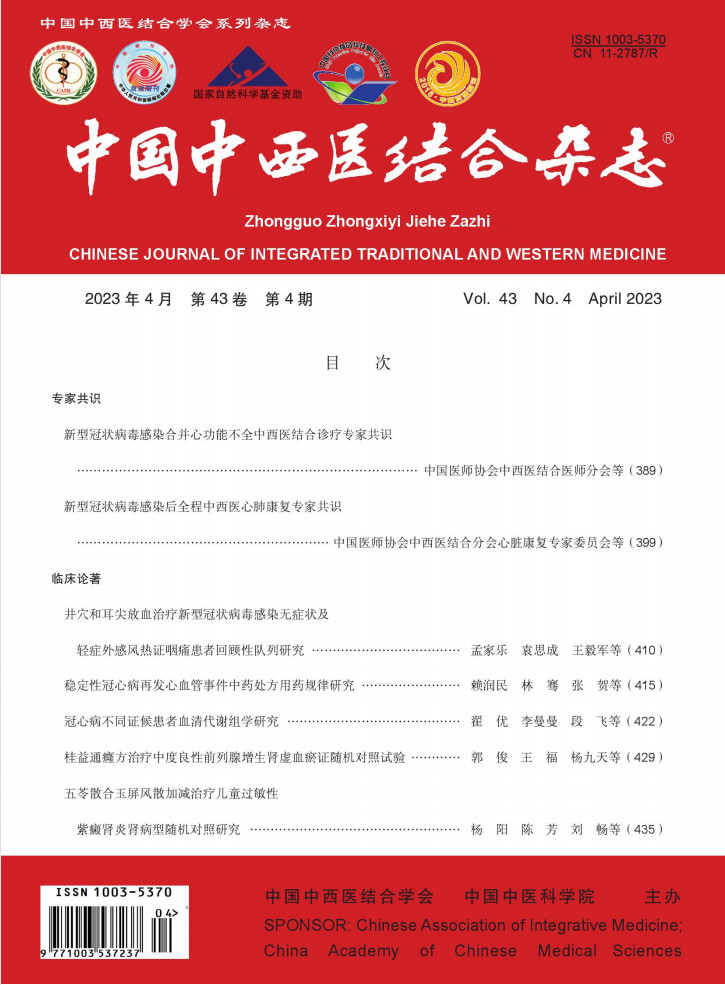关于两种计算罗库溴铵药代动力学参数Ke0方法的差异性
钱斌 郭绍明
【摘要】 目的 探讨罗库溴铵血浆-效应室平衡速率常数(Ke0)的两种计算方法的差异性。方法 22例ASA Ⅰ Ⅱ级择期手术患者,A组(n=11)持续输注罗库溴铵0.03 mg·kg-1·min-1直至4个成串刺激(TOF)降至20% 30%,B组(n=11)单次注射罗库溴铵2 mg·kg-1。A组血浆药物浓度用Sheiner等报道的药代动力学参数模拟计算,预测效应根据药代动力学-药效学关系公式换算,Ke0通过S型曲线拟合计算。B组采用Minto等提出的方法计算。结果 A、B组的Ke0平均值分别为(0.200±0.049)min-1和(0.111±0.019)min-1 (P<0.01)。结论 两种方法计算的罗库溴铵Ke0不同,有待进一步研究确定哪一个更适合于临床应用。 【关键词】 罗库溴铵 药代动力学 效应室消除速率常数 Abstract: Objective To compare two methods to calcaluate the pharmacokinetic parameter Ke0 of rocuronium so as to improve the accuracy of target-controlled effect-site concentration infusion. Methods Twenty-two ASA Ⅰ-Ⅱ patients scheduled for elective surgery were pided into two groups (n=11 each). Group A was given continuous infusion of rocuronium 0.03 mg·kg-1·min-1 up to TOF ratio of 20%-30%. The theoretical plasma concentration versus time was calculated for all patients on the basis of the pharmacokinetic models described by Sheiner et al. Predicted effect versus time was calculated by following the pharmacokinetic-pharmacodynamic link model. The Ke0 was estimated by fitting a sigmoid cure. Group B was given the drug in a bolus of 2 mg·kg-1 and the Ke0 was calculated according to the method reported by Minto et al. Results The Ke0 was(0.200±0.049) min-1 and (0.111±0.019)min-1 in group A and group B respectively, showing significant difference (P<0.01). Conclusion As the values of rocuronium Ke0 vary with the calculating methods employed, it is necessary to further study which method is appropriate for clinical application. Key words: rocuronium; pharmacokinetics; Ke0 靶控输注效应室浓度时需要参数-效应室消除速率常数,即Ke0。计算Ke0的方法有两种,一种是将血浆浓度转化为效应室浓度,然后通过“S”型效应曲线计算。另一种方法是Minto等[1]提出的峰效应时间法。本研究目的是明确这两种计算罗库溴铵Ke0的方法是否具有差异性。 1 资料和方法 1.1 病例选择和分组 22例全麻下择期腹部手术患者,男10例,女12例,ASA Ⅰ Ⅱ级,分为2组,每组11例。A组患者的平均年龄为(57±11)岁,体重(57±8) kg,B组平均年龄为 (61±12 )岁,体重(57±13) kg。2组间年龄、体重差异无显著性(P>0.05)。有下列情况者从本实验中剔除:服用了影响神经肌肉功能的药物,肝、肾、神经肌肉功能不全和(或)电解质异常,怀孕或哺乳期妇女。 1.2 麻醉方法 2组患者术前30 min均肌注苯巴比妥钠0.1 g和东莨菪碱0.3 mg,右颈内经脉穿刺置管用于罗库溴铵给药和测量中心静脉压,对侧肘静脉用于注射其他麻醉药。监测ECG、脉搏血氧饱和度(SpO2) 和呼气末二氧化碳分压(PETCO2)。吸入100%纯氧3 min后,靶控输注丙泊酚2.5 3.0 μg·ml-1,意识消失后给予芬太尼2 μg·kg-1。随后A组患者持续输注罗库溴铵0.03 mg·kg-1·min-1,当四个成串刺激(TOF)降低到20% 30%时停止输注,再次给予芬太尼3 μg·kg-1后气管插管。B组患者单次注射罗库溴铵2 mg·kg-1。研究期间采用肌松监测仪(TOF-guard, Organon, Oss, 荷兰)以15 s间隔记录TOF值,刺激电极置于腕部尺神经上,加速度换能器置于拇指,垂直于运动方向。研究过程中用靶控输注丙泊酚维持麻醉。 1.3 Ke0计算 A组和B组患者理论血浆浓度-时间数据均基于Sheiner等[2]描述的药代动力学参数并结合输注资料(体重、输注速度和输注时间等)计算,主要药代动力学参数:中央室容积(V1)=0.0385 L·kg-1,K10=0.119 min-1,K12=0.259 min-1,K21=0.163 min-1,K13=0.060 min-1,K31=0.012 min-1。用药代动力学参数计算的罗库溴铵理论血浆浓度再按Hill方程计算药物预测效应(PE)[3]: PE=Emax×CγEECγ50+CγE Emax是最大效应;γ是曲线斜率;EC50是TOF下降50%时的效应位浓度。参数γ=4.79、EC50=0.823 μg/ml、Ke0=0.168 min-1和Emax=100用于初步计算预测效应,每15 s记录的TOF值组成观察效应-时间曲线,最优Ke0解使“预测-实测效应差的平方和”最小[4]。B组患者首先确定峰效应时间(tpeak,从开始异丙酚注射到最小TOF值的时间)。因为单次注射后达tpeak时,罗库溴铵效应室浓度(CE)达到最大且等于血浆浓度(CP)。血浆浓度和效应位(μg/ml)可按给药剂量(mg)和单位分布函数(UDF)据下列公式计算[5]: CP=(tpeak)=D(mg)×∑ni=1Aie-λtpeak=CE(tpeak) A和λ是药代动力学参数,D为给药剂量(mg),随后使用CE(tpeak)按照下列等式计算Ke0值: CE(tpeak)=D(mg)∑ni=1Ke0AiKe0-λi(λie-λ tpeak-Ke0e-Ke0 tpeak) 为证实最终研究结果的准确性,我们使用研究所得的Ke0中位数及相应的药代动力学模型预测实际观察到的tpeak。 1.4 统计学处理 所有数据均首先采用柯尔莫哥洛夫-斯米尔诺夫(Kolmogorov-Smirnov)检验法检验其分布,数据正态分布时用平均值±标准差(±s )表示,非正态分布时用中位数(范围)表示,Ke0和t1/2Ke0比较用t检验,P<0.05为有显著性差异。 2 结 果 2.1 一般情况 A组罗库溴铵平均用量为(11.3±3.3) mg,输注时间为(6.8±1.7) min;B组罗库溴铵平均用量为(12.4±2.1)mg;A、B组最低TOF平均值分别为为(13±4)min和(30±17)min。以上数据组间比较,P均<0.01。 2.2 峰效应时间(tpeak ) A、B组患者注射罗库溴铵后TOF的变化趋势分别见图1和图2。可见无论是单次注射或持续输注罗库溴铵,用药后TOF的变化均具有较大的个体差异性。达最低TOF的时间A组平均为(6.5±0.8)min,B组平均为(10.5±2.5)min。组间比较:P<0.01。
[2] Sheiner LB, Stanski DR, Vozeh S, et al. Simultaneous modeling of pharmacokinetics and pharmacodynamics: application to d-tubocurarine [J]. Clin Pharmacol Ther, 1979, 25(3): 358-371.
[3] Vermeyen KM, Hoffmann VL, Saldien V. Target controlled infusion of rocuronium: analysis of effect data to select a pharmacokinetic model [J]. Br J Anaesth, 2003, 92 (2): 183-188.
[4] Plaud B, Proost JH, Wierda JM, et al. Pharmacokinetics and pharmacodynamics of rocuronium at the vocal cords and the adductor pollicis in humans [J]. Clin Pharmacol Ther, 1995, 58(2): 185-191.
[5] Muoz HR, Cortínez LI, Ibacache ME, et al. Estimation of the plasma effect site equilibration rate constant (ke0) of propofol in children using the time to peak effect: comparison with adults [J]. Anesthesiology, 2004, 101(6): 1269-1274.
[6] Kazama T, Ikeda K, Morita K, et al. Comparison of the effect-site k(eO)s of propofol for blood pressure and EEG bispectral index in elderly and younger patients [J]. Anesthesiology, 1999, 90(6): 1517-1527.
[7] Wakeling HG, Zimmerman JB, Howell S, et al. Targeting effect compartment or central compartment concentration of propofol: what predicts loss of consciousness? [J]. Anesthesiology, 1999,90(1): 92-97.
.jpg)
.jpg)
.jpg)
.jpg)

